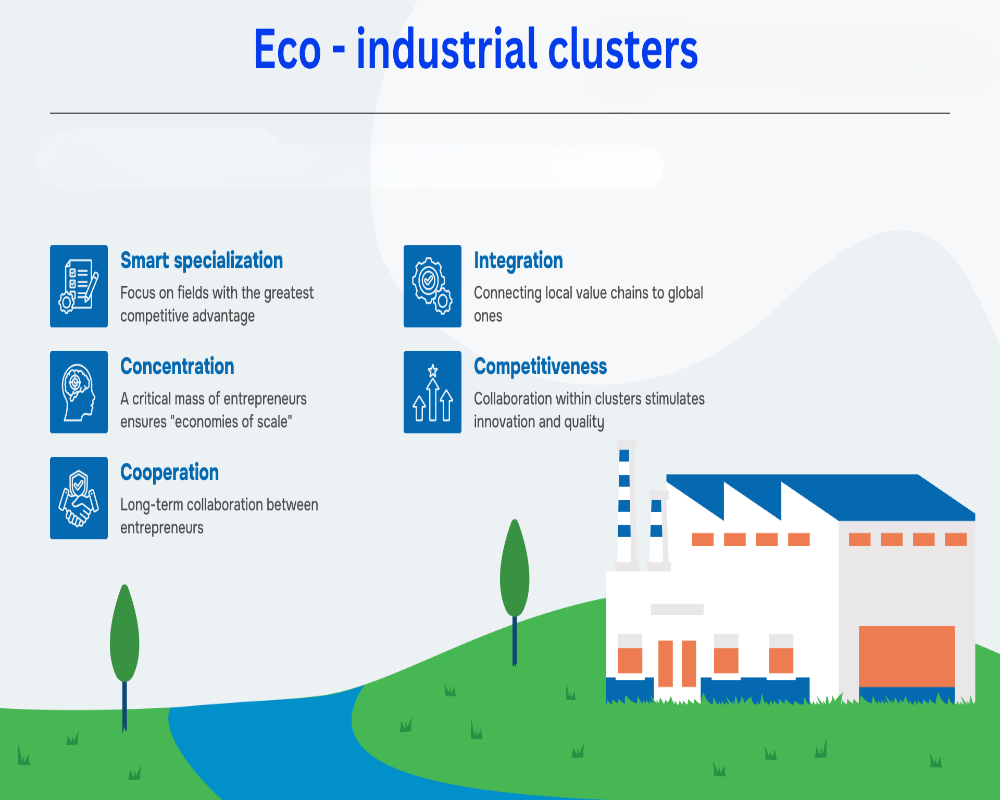Introduction
Eco-industrial clusters represent a progressive shift in industrial development, combining economic productivity with environmental stewardship and social responsibility. Unlike traditional industrial parks, these clusters are designed to foster collaboration among businesses for shared resource use, energy efficiency, and sustainable operations. Zoning laws for eco-industrial clusters provide the legal and planning framework that enables this model to function effectively. These laws govern how land is designated, developed, and managed to support green infrastructure, integrated systems, and cooperative industrial practices. As global emphasis on sustainable development intensifies, zoning frameworks for eco-industrial clusters are evolving to accommodate cleaner technologies, circular economy models, and climate-adaptive infrastructure.
Defining Eco-Industrial Clusters within the Zoning Framework
Eco-industrial clusters are planned zones where multiple industrial enterprises are located in proximity and interconnected through physical infrastructure, services, or supply chains. They are united by the principle of industrial symbiosis, which involves the exchange of materials, energy, water, and by-products among tenants to minimize waste and environmental impact. Zoning laws define and regulate these clusters as special planning districts or overlay zones, setting them apart from conventional industrial parks. These specialized zones are often supported by incentives, flexible building codes, and performance-based standards that prioritize environmental outcomes over rigid land use classifications.
Purpose of Zoning Laws in Eco-Industrial Development
The primary purpose of zoning laws in eco-industrial cluster development is to establish a supportive legal structure that enables integrated land use and infrastructure planning. These laws ensure that the layout, function, and operation of the cluster adhere to sustainability goals, including reduced emissions, resource efficiency, and community inclusion. Zoning codes serve to regulate densities, land use mix, building orientations, and proximity of facilities to encourage shared utility services, such as combined heat and power (CHP) systems, renewable energy installations, or centralized wastewater treatment.
Furthermore, zoning facilitates strategic spatial arrangements where anchor tenants (such as a major manufacturer or recycler) can serve as resource hubs for other smaller businesses in the cluster. This approach enables value chain integration, promotes cost efficiency, and enhances the collective environmental performance of the zone.
Incorporation of Environmental Design Standards
Eco-industrial cluster zoning laws go beyond traditional land use regulation by embedding environmental design requirements. These may include mandatory green building certifications, landscape conservation rules, stormwater management, and minimum standards for waste segregation or recycling infrastructure. Zoning provisions may also encourage or require on-site renewable energy generation, such as solar or wind installations, and provide allowances for experimental or transitional green technologies.
Additionally, zoning frameworks for eco-industrial zones often support the use of permeable paving, rain gardens, bio-swales, and other low-impact development (LID) practices to control runoff and maintain ecological balance. These measures not only mitigate the environmental footprint but also contribute to the visual and functional quality of the industrial environment.
Flexibility and Mixed-Use Integration
Modern zoning codes for eco-industrial clusters emphasize flexibility to accommodate a mix of compatible uses and evolving technologies. This may include allowing limited commercial, institutional, or even residential uses within the zone, especially for worker accommodations, training centers, or R&D labs. Mixed-use zoning enhances the social dimension of sustainability by promoting live-work environments, reducing travel distances, and supporting local economies.
In some jurisdictions, zoning laws may allow for hybrid land use models that combine industrial activities with education, innovation, and service functions, provided that environmental thresholds are maintained. This adaptability is essential in encouraging innovation-driven industries, cleantech businesses, and small enterprises that thrive in integrated, collaborative environments.
Supportive Governance and Performance-Based Zoning
Zoning for eco-industrial clusters is often governed by performance-based standards rather than rigid prescriptions. Instead of focusing solely on the types of activities permitted, performance zoning emphasizes outcomes such as reduced energy use, emissions control, water conservation, and waste minimization. Developers and occupants may be required to demonstrate compliance with these goals through sustainability audits, lifecycle assessments, or environmental management systems.
Such zoning models require active collaboration between local planning authorities, environmental regulators, and cluster management bodies. These stakeholders coordinate on infrastructure provision, compliance monitoring, and incentive distribution to ensure that the zoning framework supports both regulatory objectives and industrial competitiveness.
Conclusion
Zoning laws for eco-industrial clusters provide the foundation for a new generation of sustainable, resilient, and economically viable industrial developments. By enabling mixed-use integration, incentivizing green infrastructure, and supporting resource-sharing strategies, these laws foster an industrial ecosystem that aligns with global sustainability goals. As cities and regions strive to balance economic growth with environmental responsibility, zoning for eco-industrial clusters offers a forward-looking planning solution that bridges policy, innovation, and practical implementation. A robust zoning framework is not only necessary to regulate eco-industrial clusters—it is key to unlocking their full potential as drivers of circular economy, green jobs, and industrial transformation.
Hashtags
#ZoningLaws #EcoIndustrialClusters #SustainableDevelopment #UrbanPlanning #GreenEconomy #EnvironmentalRegulations #SmartGrowth #SustainableCities #IndustrialZoning #EcoFriendlyBusiness #CommunityPlanning #RenewableEnergy #CircularEconomy #LandUsePlanning #SustainableIndustry #EcoInnovation #LocalEconomies #EnvironmentalSustainability #ZoningRegulations #FutureOfCities


